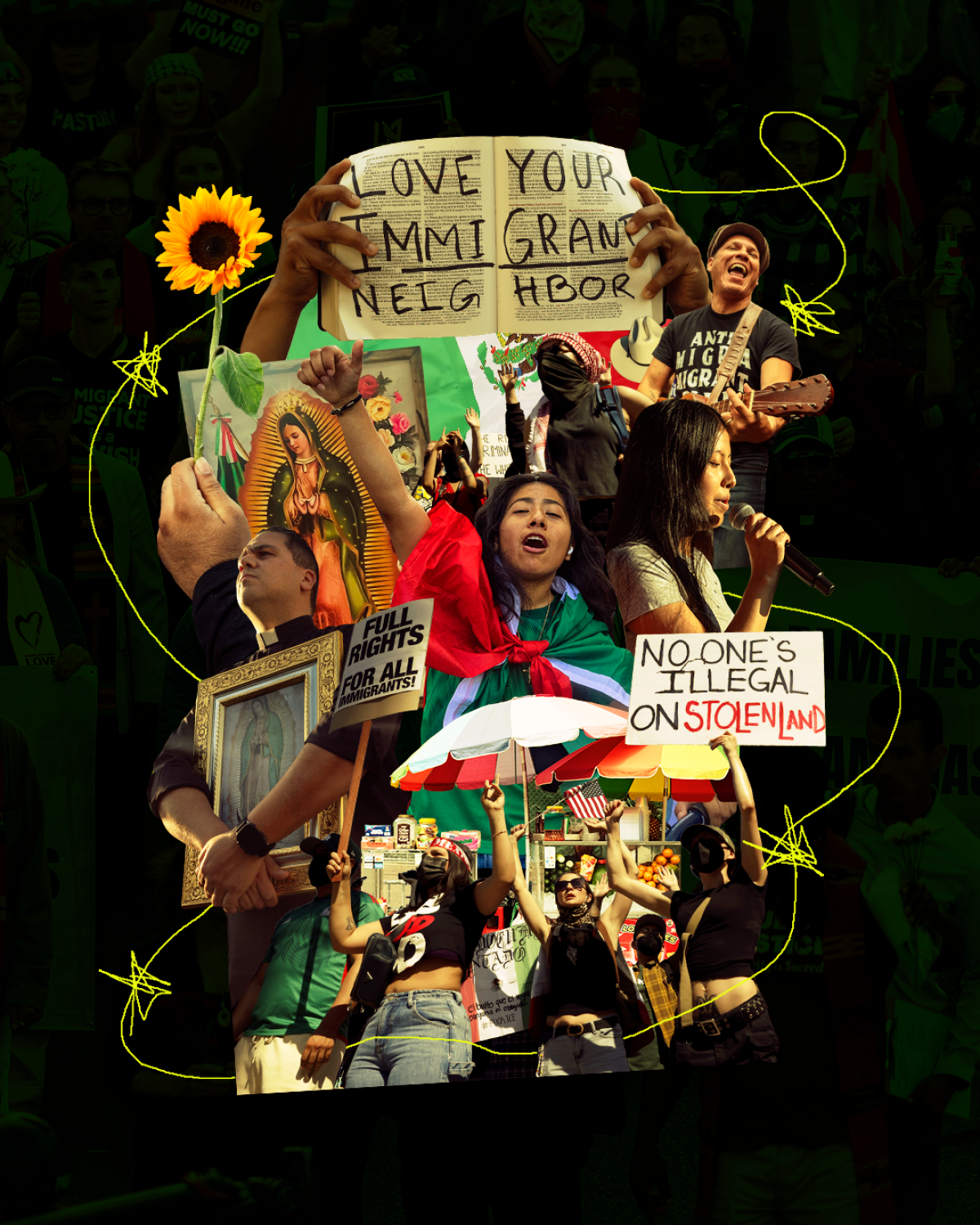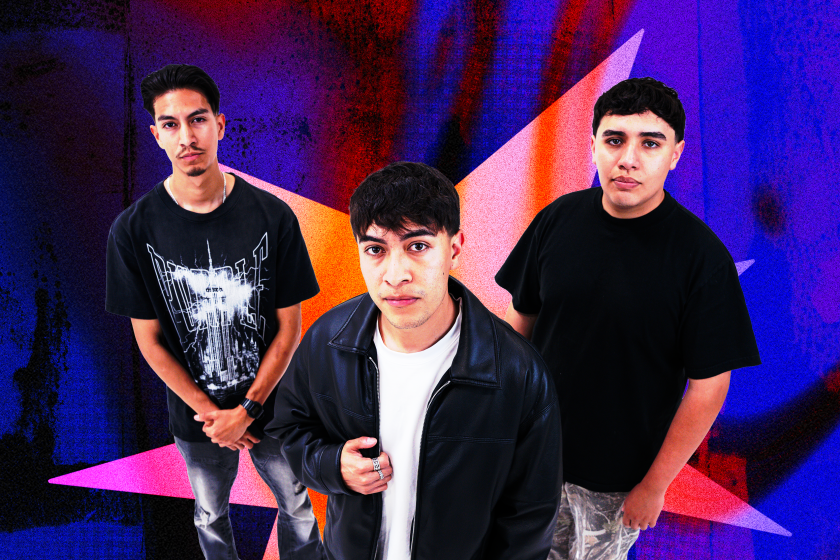The ICE protests have proved that L.A. shows up for itself

- Share via
A politician with a bend toward authoritarianism sending in armed troops in order to create the optics that will help him manufacture consent to further consolidate power. Unauthorized workers subjected to state-sanctioned terror from immigration officers. Everyday citizens, galvanized and radicalized by the presence of the military in their city, choosing to fight back.
No, I’m not talking about the second and final season of “Andor,” the critically acclaimed Disney+ show and “Star Wars” property that gives us the back story on how the Rebel Alliance came to be. What I’m describing didn’t take place in a galaxy far, far away. It’s currently happening here in Los Angeles.
You’re reading Latinx Files
Fidel Martinez delves into the latest stories that capture the multitudes within the American Latinx community.
You may occasionally receive promotional content from the Los Angeles Times.
Since Friday, U.S. Immigration and Customs Enforcement has carried out large-scale sweeps across L.A., targeting places like Home Depots, the downtown Garment District and car washes. ICE agents have hit neighborhoods and cities with large Latino populations, places like Westlake, Huntington Park and Downey.
According to the Wall Street Journal, the raids came at the directive of White House aide Stephen Miller, who ordered ICE leadership to “just go out there and arrest illegal aliens” in an effort to deliver on Trump’s campaign promise of mass deportations. As of Wednesday, 330 immigrants have been arrested, with that figure likely to increase in the coming days.
What followed was a week of protests that resulted in the Trump administration nationalizing the California National Guard — against the wishes and without the consent of Gov. Gavin Newsom — and deploying 4,000 Guardsmen. Images of protesters clashing with various local law enforcement officers disseminated on social media and filled up airwaves of cable news.
But contrary to popular opinion outside of L.A., the anti-ICE demonstrations have largely been peaceful. With the exception of a handful of Waymo driverless cars, L.A. has not been set on fire. Nor was it a war zone or a hellscape. For starters, much of the protesting has been contained to the Civic Center, a cluster of government buildings spread out over a few city blocks at the northern edge of downtown.
To help dispel various myths about what actually transpired, several of my colleagues put together this article.
But just to be sure, I headed downtown on Monday afternoon to see for myself.
The first thing I noticed after exiting the Historic Broadway Metro station was the graffiti. Just about every building I encountered on my short walk to the Edward R. Roybal Federal Building was covered in anti-ICE messaging.
When I finally got to my destination, I found hundreds of Angelenos from all walks of life peacefully and loudly exercising their 1st Amendment right to protest. They carried pro-immigrant signs and chanted slogans like “National Guard, out of L.A.!” Volunteers moved throughout the crowd, handing out face masks, water and snacks.
At one point, an older Black man in a wheelchair with a speaker tied to it elicited some cheers from protesters close to him after he played “To Live and Die in L.A.,” the Tupac Shakur 1996 anthem that extols the many virtues of our fair city — ”It wouldn’t be L.A. without Mexicans. Black love, Brown Pride in the sets again,” the song goes.
Were there chaos agents present? Sure. On more than one occasion, I spotted someone with a can of spray paint in his hand — they were all young men — tagging a wall.
Around 4:30 p.m., Coral Alonso, a 27-year-old mariachi player, moved toward the front of the gathering with a portable PA system and serenaded the crowd with ranchera staples like “El Rey” and “Cielito Lindo.” Strangers danced with one another, and those who knew the lyrics sang along.
As it got closer to 5 p.m., word spread through the crowd that the LAPD had declared an unlawful assembly and ordered everyone to disperse. The mood quickly dampened. It didn’t take long for the police to start shooting so-called non-lethal rounds at the crowd to get people to comply.
Many chose to stay. I headed home.
What I witnessed that afternoon wasn’t troubling or horrifying. On the contrary, what I saw was Angelenos showing up for their most vulnerable neighbors to let them and the powers that be know that an attack on one of us is an attack on all of us.
Consider subscribing to the Los Angeles Times
Your support helps us deliver the news that matters most. Become a subscriber.
Quote of the week

“If this is how this administration responds to a senator with a question, if this how the Department of Homeland Security responds to a senator with a question, you can only imagine what they’re doing to farm workers, to cooks, to day laborers out in the Los Angeles community and throughout California and throughout the country.”
— Sen. Alex Padilla (D-Calif.), speaking to media on Thursday afternoon after he was forcibly removed and handcuffed by FBI agents during a Department of Homeland Security press conference held at the Wilshire Federal Building in West L.A. Padilla had tried to ask DHS Secretary Kristi Noem a question before the fracas.
For a full account of events, go here.
Should people wave the Mexican flag, or that of other countries, at protests?

Stories we read this week that we think you should read
From the L.A. Times:
These street vendors used their aguas frescas to fight tear gas at anti-ICE protests
It can’t be a protest in L.A. without street food. Meet the vendors who want to go down in “history books” for serving and aiding anti-ICE protesters.
ICE expands immigration raids into California’s agricultural heartland
Alarm spread through California agricultural centers Tuesday as panicked workers reported that federal immigration authorities were showing up at farm fields and packinghouses from the Central Coast to the San Joaquin Valley.
As Marines arrive in L.A., military experts raise concerns: ‘This could spiral out of control’
After days of fiery protest against federal immigration raids, Los Angeles residents and officials braced for the arrival of hundreds of U.S. Marines on Tuesday in what some called an unprecedented and potentially explosive deployment of active-duty troops with hazy mission objectives.
Amid protests, questions loom about how active ICE will be at Club World Cup games
After U.S. Customs and Border Protection announced on social media that it will be at the Club World Cup opener in Florida, a FIFA source couldn’t rule out ICE agents working at L.A. games.
To understand what immigrants mean to California, eat at any restaurant
Food critic Bill Addison on what makes California and its cuisine so great.
Immigration raids have shaken communities across Los Angeles County. How can you help?
Los Angeles County residents can support local and regional organizations that are directly supporting families who were affected by recent ICE raids and immigrant communities in need.
“Agushto Papá” challenges música Mexicana artists to speak up on immigration raids
Podcasters Jason Nuñez, Diego Mondragon and Angel Lopez highlighted budding música Mexicana acts for years. Now they’re using their platform to call them out for staying silent about recent immigration raids.
Becky G, Ivan Cornejo, Maná lead Latinx musicians’ response to the ongoing L.A. ICE raids
As ICE raids continue in L.A., Latin musical artists like Becky G, Ivan Cornejo and Maná are taking to social media to voice their support for immigrant communities.
From elsewhere
I’m the daughter of immigrants. The L.A. I know isn’t in the news. [Vox]
My former colleague Gabriela Fernandez, a lifelong Angelena, wrote about what it was like to see her city be mischaracterized in the news.
In this op-ed, reporter Tina Vasquez argues that the ongoing ICE raids in L.A. are a declaration of war by the federal government. It’s a battle, she say, where they don’t stand a chance.
How to protest safely in the age of surveillance [Wired]
Reporters Andy Greenberg and Lily Hay Newman have compiled this guide for how protesters can protect themselves technologically while demonstrating.
Insights
L.A. Times Insights delivers AI-generated analysis on Voices content to offer all points of view. Insights does not appear on any news articles.
Viewpoint
Perspectives
The following AI-generated content is powered by Perplexity. The Los Angeles Times editorial staff does not create or edit the content.
Ideas expressed in the piece
- The article frames the Los Angeles ICE protests as a grassroots response to federal overreach, emphasizing community solidarity and peaceful resistance despite portrayals of chaos in national media[1][2].
- Local leaders, including Gov. Gavin Newsom and Mayor Karen Bass, condemn the Trump administration’s deployment of the National Guard without state consent, arguing it inflames tensions and violates California’s sovereignty[1][2].
- Protesters are depicted as diverse and organized, with mutual-aid efforts like distributing water and masks, cultural expressions (e.g., mariachi performances), and a focus on protecting vulnerable immigrant communities[3].
- The author critiques the federal raids as politically motivated, linking them to Trump campaign promises and Stephen Miller’s directives, while highlighting the economic and cultural centrality of immigrants to Los Angeles[2][3].
Different views on the topic
- Federal authorities, including the Department of Homeland Security, accuse protesters of violence, citing assaults on ICE officers, property destruction, and delays in local law enforcement response[4].
- The Trump administration justifies National Guard deployment as necessary to protect federal personnel and facilities, framing protests as lawless riots rather than legitimate dissent[1][4].
- Critics argue California’s “sanctuary” policies obstruct federal immigration enforcement, with DHS blaming Democratic leaders for inciting hostility toward ICE through rhetoric that “villainizes” law enforcement[4].
- Some commentators characterize the protests as destabilizing, pointing to vandalism, clashes with police, and disruptions to public order as evidence of misplaced priorities among activists[2][4].
The Latinx experience chronicled
Get the Latinx Files newsletter for stories that capture the multitudes within our communities.
You may occasionally receive promotional content from the Los Angeles Times.




